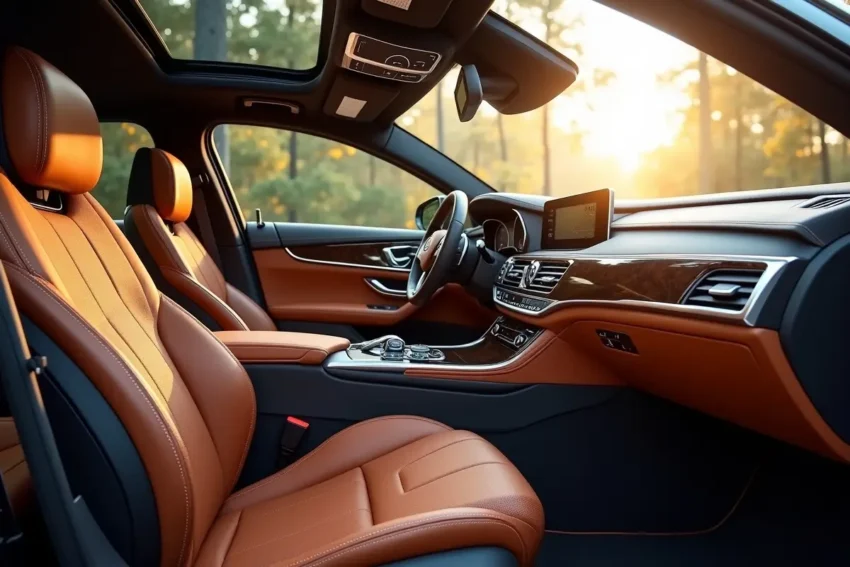Key Elements That Define Luxury in Automotive Design

The world of automotive design is a fascinating blend of art and engineering, manifesting itself through a wide array of styles, features, and innovations. As the automotive industry continually evolves, the concept of luxury has reached new heights.
To truly understand what defines luxury in automotive design, it’s important to explore various elements that contribute to this premium experience, from materials to technological integration, and from design philosophy to brand perception.
Contents
Material Selection
One of the primary elements defining luxury in automotive design is the selection of materials. Manufacturers go beyond traditional metal and plastic, opting instead for high-grade materials such as leather, natural wood, and carbon fiber.
High-quality leather upholstery is often hand-stitched by skilled artisans, providing a tactile and visual richness that is unmatched. Natural wood trims, sourced from sustainable forests and expertly crafted, add an exquisite touch that enhances the car’s aesthetics.
The interiors of luxury vehicles often feature unique textures and finishes, drawing attention to their functionality. This attention to detail conveys a message about the brand’s commitment to excellence, which is crucial for discerning buyers. Premium materials are often coupled with innovative production techniques, ensuring that every component serves its purpose while still contributing to the luxurious feel of the car.
Design Philosophy
The design philosophy behind luxury automotive brands is a significant factor in setting them apart from more mainstream producers. Luxury car designers aim to fuse elegance with performance, creating vehicles that are visually striking, functional, and aerodynamic. Often, this involves collaboration with world-class artists and designers who contribute to a vehicle’s visual narrative.
A notable example is the iconic silhouette of a Rolls-Royce, where every curve and line reflects an unparalleled beauty. The design philosophy of brands like Rolls-Royce emphasizes timelessness over trends, explains this rolls royce dealer in Charlotte, leading to vehicles that can be admired for decades. This commitment to aesthetic longevity resonates deeply within the luxury market, where customers seek exclusivity and refinement.
Technological Integration
Advancements in technology are a cornerstone of modern luxury car design. Integrating cutting-edge technology enhances the driving experience and the sense of luxury that comes with owning a high-end vehicle. From advanced infotainment systems to intricate driver-assistance features, modern luxury vehicles offer an array of technologies designed to provide comfort, convenience, and safety.
Luxury automotive brands often indulge in bespoke technological enhancements, allowing customers to personalize their vehicles based on individual preferences. A buyer can choose from an exquisite array of audio systems, climate controls, and dash designs, ensuring that their vehicle reflects their personal style. This focus on personalization enhances the luxury experience, differentiating high-end brands from their non-luxury counterparts.
Craftsmanship and Attention to Detail
Craftsmanship is at the heart of luxury automotive design, with brands emphasizing hand-built models and meticulous attention to detail. Expert artisans spend countless hours perfecting each interior and exterior component, ensuring quality that can’t be mass-produced. Features such as hand-finished surfaces and custom paint jobs are standard in the luxury segment, demonstrating a commitment to excellence that truly sets these vehicles apart.
In many cases, this level of craftsmanship involves traditional techniques interwoven with modern production methods to create vehicles that are built to last. The stories behind these creations, from the artisans who shape each element to the master craftsmen who assemble the final product, infuse the automobile with a sense of exclusivity and heritage that is vital to its luxury status.
Performance and Driving Experience
Luxury in automotive design extends beyond appearance; it encompasses how the vehicle performs on the road. This involves the engineering of high-performance engines, advanced suspension systems, and meticulous tuning to ensure a smooth and powerful ride. Luxury vehicles are often engineered to provide a driving experience that is both exhilarating and serene, catering to drivers who value performance as much as comfort.
Many luxury automotive brands invest heavily in research and development, creating vehicles that boast efficient fuel consumption and low emissions. This commitment to sustainable performance illustrates the dual responsibility both to the driver and to the environment. Buyers expect to experience premium performance without compromising their values, making this aspect increasingly relevant in modern luxury automotive design.
Brand Heritage and Image
The heritage and image of an automotive brand play a significant role in defining its luxury status. Established luxury brands often carry a century-long reputation of excellence, craftsmanship, and innovation. This brand heritage serves as a source of pride for owners. A car is often seen as a statement of identity, and consumers are drawn to brands that resonate with their personal values.
The marketing of luxury automobiles focuses heavily on experiences rather than just the product itself. Events, showrooms, and experiences curated by the brands create an atmosphere of exclusivity and affluence that appeals to the luxury buyer. The ownership experience becomes as important as the vehicle itself, which reinforces the luxury brand’s standing in the market.
Sustainability in Luxury Automotive Design
Sustainability has emerged as a crucial element in automotive design, including luxury segments. High-end manufacturers are integrating eco-friendly materials and processes into their operations. This shift reflects a growing consumer demand for sustainability without compromising quality or luxury. Innovations such as electric vehicles and hybrid models show that traditional luxury can adapt to modern values.
Luxury brands are now incorporating sustainable practices in sourcing materials, production, and even after-sales service. An eco-friendly interior or an efficient, low-emission engine is often seen as just another piece of the luxury puzzle. This evolution ensures that high-end brands remain relevant.
Each of these key elements contributes to the perception and experience of luxury in automotive design, creating an environment that emphasizes quality, performance, and exclusivity. Today’s luxury car buyers are looking for more than just transportation; they are seeking an automotive experience that reflects their aspirations and lifestyle.



